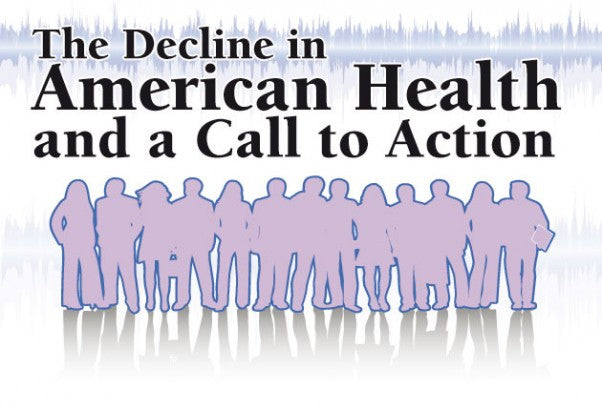Are we as healthy as we were 100 years ago? How about 50 years ago? Even 15 years ago? When we look at the statistics over time we notice a marked change in diabetes from 1994 to 2007. What a difference a decade can make!
More than a quarter of all adults are not just overweight, but obese; and about 10 percent of them have diabetes on the eastern half of the USA. Not to mention, the projected lifespan of the next generation will be shorter than their parents’. Many nations experience better health than the USA. The USA ranks 50th for life expectancy compared to other countries. In infant mortality, the USA ranks 47th out of 222 nations — Cuba, Spain, Greece, the Czech Republic, and Bermuda are just a few that fair better than we do. Maternal mortality rate in the USA is double the rate in Canada, quadruple the rate in Japan, and 12-fold higher than in Greece. And it isn’t that we aren’t spending enough money. We spend more of our GDP than any other country on so-called health care, yet have very poor health. National health expenditures totaled 17.6% of GDP in 2009, up from 5% in 1960 and 7% in 1970. One of the most dramatic changes that has affected our health is our food supply. Electricity and freezers were the first big innovation that affected the food supply. What used to be a local and fresh affair could now be global.
Over the last 50 to 70 years, the small to mid-size farmer has disappeared and has been replaced by very large agri-businesses. Local grocery stores and restaurants have been replaced with large chains and international franchises. Big franchises command prices; they also demand a steady, guaranteed flow of food, something that can’t be met by the small farms working alone. The USDA’s 2007 Agricultural Census revealed that 59% (up from 47% in 2002) of all American agricultural products are provided by just 2.5% of the farms, those 55,600 farms with sales greater than $1 million per year. Almost half of that amount, 28% of the nation’s agricultural products, come from just 5,500 farms with sales over $5 million per year. So, the food channels have become very large, efficient, and have not had our health at the forefront of their concerns.
These changes are not all bad (like electricity), but they have to be utilized in a way that serves us rather than makes us its slave. It’s great to have frozen berries year round, yet we have fresh produce across the nation in the middle of the winter. We have access to exotic and tropical fruits from across the world. But it is also possible to eat now without knowing anything about preparing food - you just have to open a box, a can, a freezer container, pop it in the microwave, and call it dinner. The amount of ready-made dinners in the market place and the number of people eating them is staggering!
The real problem we see is the change in lifestyle. We are now in our second generation of Americans who don’t know how to prepare food. They live on shelf stable meal packets and frozen dinners. A Mintel survey in 2010 revealed that 23 meals a month per household are from this category of food, with even higher amounts among young adults (18-34 year olds). And this doesn’t count restaurants. The restaurant business now claims 49% of our food dollars, up from 25% in 1955. The younger generation’s parents didn’t cook, leaving them at the mercy of the food industry.
We are also no longer a rural nation with family activity centered around a healthy meal. Eighty percent of the population lives on just 3% of the land. We mostly live in houses or apartments stacked right beside each other. With Mom and Dad both working (or just one in many single-parent homes), children busy with school and after-school activities, there is so much activity that life can be very hectic. There is no time, it seems, to prepare food at home. But it doesn’t matter so much, because no one is at home to eat it! Only about 58% of teens have dinner with their families five or more times a week. Family dinner is a lost habit for way too many of us. But that time for connecting together around the table is important for children. Those children who infrequently eat dinner with their family, compared to those who frequently do so, are four times more likely to use tobacco, more than twice as likely to use alcohol, 2.5 times as likely to use marijuana, and four times more likely to expect to use drugs in the future. Who is going to teach your children what good food is? The TV? The meat and dairy industry-influenced school system? Fathers and mothers have been given the responsibility by God Almighty to raise their children in truth. We need to get a hold of the truth and make sure our children grab on as well!
The third big change that has affected our health has come from the medical industry. Flush with victories with antibiotics and vaccines (a public health propaganda victory really) the public assumed that doctors understood what was required to be healthy and how to help people when they were sick. The truth is that doctors are not trained to understand health. They are trained to diagnose disease. But the medical system, especially the pharmaceutical industry, supplied them with their exclusive set of tools and outlawed any other method of medical practice. However, no one is sick because of a deficiency in pharmaceutical drugs. Drugs only suppress the symptoms and other drugs are needed to treat the side-effects of the first drug. You can get a pill for just about any ill and now our seniors take a tremendous amount of pharmaceutical compounds, between 2 and 6 drugs a day.
So, the deck seems stacked against our health. The food supply system, our busy, modern urban lifestyles, and the medical system seem to conspire against our health. Is there a way to change and break free?
First, take responsibility for your own health. You are the one who will suffer if you don’t take action. You are the one who will pay the ultimate price of a sick and short life if you don’t take care of your own health. Educate yourself. Your health is in your hands. Second, learn to prepare your own food from basic ingredients. It can be simple or gourmet. Do not rely on food companies or restaurants to provide you with wholesome food. Eat dinner together as a family. It is not just the conversation that is important. The food should support health as well as taste good. Third, incorporate more activity into your lifestyle, whether it is a daily walk, an exercise routine, or more leisure activities that get you outside. Spend most of your free time doing activities that require movement. Fourth, be an example. Whether you are a mom at home, a pastor in a church, a teacher, a businessman, a pilot, a lawyer, or whatever, you have a sphere of influence.
If you don’t promote a healthy diet and lifestyle, who will? Television chef personality Jamie Oliver is one example. You may think he is not as enlightened as you regarding a healthy diet, but he is taking his knowledge and making a difference. He is changing lives and moving people in the right direction. There are many more like him, too. The Farm to School movement is also making a difference. All 50 states now have at least one program getting some of their food from local farmers and educating children on where their food comes from. It is a national travesty that children don’t even recognize common vegetables, and a little bit of education goes a long way on impressionable minds, especially when backed up at home. Safeway, Inc. has made strides in health care by tying premium discounts to health indicators (blood pressure, cholesterol, weight, and tobacco use) of its employees. Rising costs have been curbed and employees are healthier and probably more productive.
Whatever your sphere of influence, speak up and make a difference. Realistically, not everyone will adopt The Hallelujah Diet, but everyone can make strides toward a whole-foods, plant-based diet. Everyone needs to come to an understanding that they are personally responsible for their own health, not their doctor or the government.







